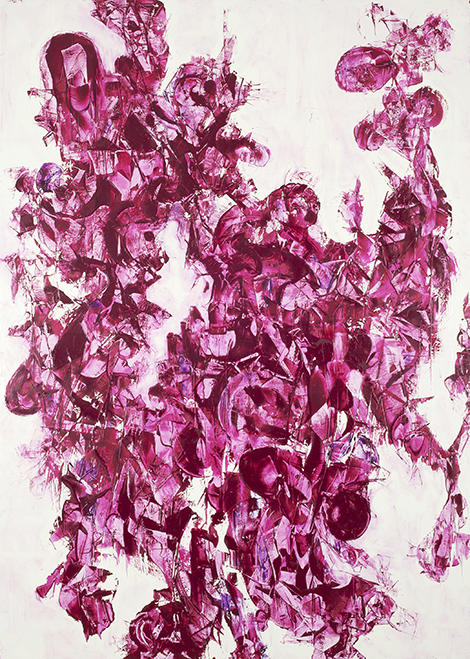Originally from the East Coast, San Francisco-based artist Richard Hoblock displays a palpable joy in the process and materials of painting, his second career. Previously immersed in the film and arts communities of Los Angeles, he obtained an MFA in 1998 from UCLA’s film department, where he later taught. Hoblock’s film credits include Tarantella (1995), a mainstream feature film, and Woof (2004), a short art film featuring Nayland Blake.
“New Paintings” (all works 2014) at Anthony Meier Fine Arts included four massive vertical canvases, each seven feet in height. In one of these, Corista, Hoblock uses muscular, broad palette-knife strokes to create an energy that ascends in a spreading, red organic form almost suggesting flowers. This expansive passage is enveloped in a surrounding ground of white tinged with pink and peach, and Hoblock’s back-and-forth process of scraping away paint to reveal layers beneath charges the surface with ambiguity.
Titles infuse amorphous narrative into these works. Tai Tai, which translates as “wife” in Chinese, offers a loosely-defined shape of purple, gestural marks and hints of blue and yellow flickering around the edges, suggesting a feeling of figuration, like dancers in motion. Hoblock’s abstract forms lend themselves, like a Rorschach test, to open-ended interpretation, in which fragments of bodies or fluttering fans are perhaps merely reflections of the viewer’s own state of mind.
Three small works in oil on linen hinge on surface and gesture. All That, painted in hues of terra cotta, is somewhat Cubist and vaguely floral in nature, bearing marks from being wiped with a rag, as well as scratches from a palette knife or the end of a brush. There is more than a little Lee Krasner in many of the works. Hoblock shares with Krasner a tough-minded mining of process-oriented abstraction, coupled with a highly formal, and somewhat hermetic aesthetic sense. Like the action painters of the 1950s, Hoblock’s choices are made in a sequential manner, one decision motivating the next; here the criteria by which gestures achieve primacy is ultimately part of the artist’s unique internal dialogue with the painting—a conversation in which viewer participation is not invited.
Concealment is an important part of Hoblock’s process, in which early layers of color and gesture are covered up, perhaps only glimpsed as residue on the edges, and retained solely in the memory of the artist. This destruction or, in a sense, recycling of the initial layers of his paintings as part of the working process also relates strongly to the work of Krasner, who famously cut apart and reassembled her earlier works into new compositions.
One might draw a parallel between Hoblock’s relinquishing his earlier career as a filmmaker to reinvent himself as a painter with the way in which he creates substantial layers of underpainting, only to be obliterated to make way for new incarnations of the work: paintings which ultimately resonate with strength and intensity—tempered by a fine and discreet sense of control.




















0 Comments